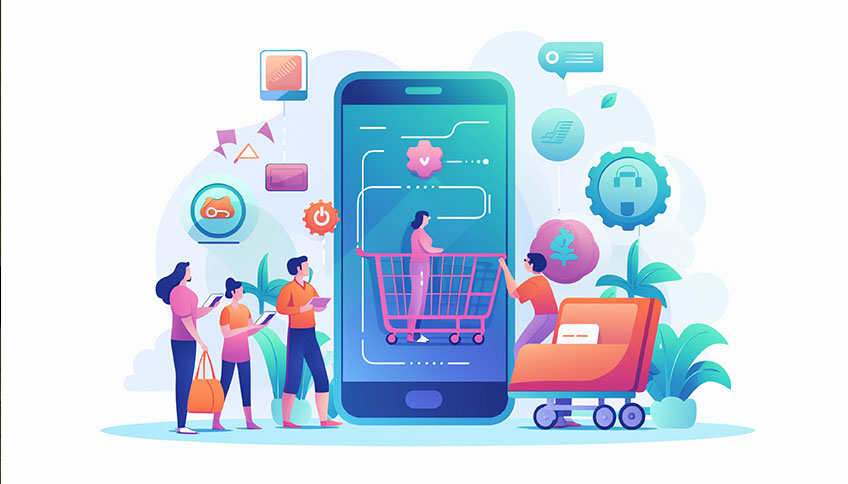The steps in eCommerce app development services can either make or break app impression. Choose reliable services to ensure success.
eCommerce App Development Company Steps: What All It Entails
Are you ready to transform your eCommerce vision into a thriving app? The digital sphere is evolving, presenting unparalleled opportunities across industries. From healthcare to travel, digital solutions are flourishing, with reputed eCommerce app development company leading the charge.
Modern consumers prioritise convenience, favouring accessible services. The online shopping trend has surged, fuelling the demand for eCommerce apps. Business owners are capitalizing on this trend by partnering with eCommerce app development companies for seamless solutions. Leveraging website-to-app converters can expedite this process, converting your eCommerce website into a dynamic app.
While creating an eCommerce app is within reach, it demands a strategic approach for success. Partnering with the right development team can elevate your project and ensure a seamless transition into the app realm.
What is Mobile Commerce App?
The roots of electronic commerce stretch back approximately four decades to the visionary efforts of English entrepreneur Michael Aldrich. Despite encountering initial scepticism, Aldrich’s concept laid the foundation for a transformational shift in commerce that has since become inseparable from modern life.
At its core, eCommerce encompasses the online trading of commercial goods, facilitated by electronic transactions conducted through smartphones or computers. This paradigm shift has been fuelled by technological advancements, globalization, and a growing consumer appetite for variety and enhanced shopping experiences.
As traditional brick-and-mortar stores adapt to the digital age, the demand for eCommerce app development company services has soared. These apps serve as the gateway for businesses to transition their operations online, meeting the evolving needs of today’s consumers.
Step-by-step Guide to eCommerce App Development Services
The success of an eCommerce application depends on developing the right strategy and working in sync with it. With the right strategy, an eCommerce application is sure to gain the required success.
Let’s start with these steps one by one:
Selecting the Niche
Selecting a focused area of operation is paramount when considering Ecommerce development agency services. It sets the stage for all subsequent features and functionalities. This decision encompasses everything from your target end-users to the specific industry vertical you aim to serve.
E-commerce solutions can be categorised based on several criteria:
Business-to-Business (B2B): This involves digital transactions between businesses, catering to the needs of enterprises seeking to conduct commerce with one another.
Business-to-Consumer (B2C): In this model, businesses sell their products or services directly to individual consumers, forming the backbone of most online retail operations.
Consumer-to-Consumer (C2C): This category encompasses transactions conducted solely between consumers, often facilitated by online platforms that connect individuals looking to buy or sell goods or services.
Consumer-to-Business (C2B): Here, individuals create value or offer services that businesses can then purchase, representing a unique reversal of the traditional business-consumer dynamic.
Additionally, e-commerce solutions can be tailored to specific industries, ranging from retail to online marketing and digital advertising. Your application’s success hinges on its ability to effectively target and serve the unique needs of your chosen market segment.
Researching Target Audience
Before diving into the development process of any eCommerce app development company, it’s crucial to conduct thorough research on both your competitors and target audience. This step will not only help you refine your vision but also shape your application to meet the needs and expectations of your users.
Competitor analysis is key to understanding the current landscape of similar solutions. By studying your competitors, you can identify the technologies, UX/UI trends, and revenue models that are most effective in your industry. Additionally, analysing customer reviews will provide valuable insights into the strengths and weaknesses of existing solutions, helping you differentiate your product.
In parallel, defining your target audience is essential. By identifying the user group most relevant and loyal to your brand, you can tailor your application to meet their specific needs and preferences. This can be done through analysing your customer base, conducting market research, or studying your competitors’ audience.
Get Services from Reliable eCommerce Website Development Company
Building a successful shopping app requires a skilled and cohesive Ecommerce App Development Company. When starting from scratch, your team should ideally include the following specialists:
Business Analyst: Responsible for defining and documenting business requirements, and ensuring that the software meets these requirements.
Project Manager: Oversees the entire development process, ensuring that tasks are completed on time and within budget.
iOS Developers: Experts in iOS-specific technologies, responsible for developing the app for Apple devices.
Android Developers: Proficient in Android-specific technologies, responsible for developing the app for Android devices.
Back-end Developers: Specialists in server-side technologies, responsible for implementing data storage and other server-side functionality.
Quality Assurance Team: Conducts tests, audits, and validations to ensure the app meets quality and performance standards.
UX/UI Designers: Design the app’s user interface and experience, ensuring it is visually appealing, user-friendly, and intuitive.
You can choose to hire these experts in-house or outsource your mobile development to a third-party vendor. In-house development can be costlier but offers greater control over the process. Outsourcing, on the other hand, can be more cost-effective and may provide access to a broader range of expertise. Freelancers can also be a viable option for specific, narrowly defined tasks within the development process.
Shaping the Concept
In this crucial phase, your development team immerses themselves in your app concept. Business analysts work to understand the nuances of your eCommerce vision, placing it within the context of your business framework. Meanwhile, tech experts collaborate to devise a strategic blend of technologies that will seamlessly translate your idea into a robust solution.
The outcome of this intensive collaboration is a meticulously curated set of must-have features. These features form the foundation of your minimum viable product (MVP), representing the core functionalities essential for your app’s initial launch. Additional, ‘nice-to-have’ features are earmarked for incorporation at a later stage, strategically placed to enhance user experience and add value as your app evolves.
Designing Compelling UI/UX
Armed with detailed user personas, UI/UX designers embark on crafting a design layout that seamlessly guides users through their journey on your application. Adhering to the principles of mobile UX design, the team adds essential elements to ensure your eCommerce app is not just functional, but also user-friendly, convenient, and visually appealing.
Drawing from best practices and top-grossing eCommerce mobile applications, the design incorporates key features such as visual commerce, enabling rich product descriptions and image zooming to enhance the shopping experience. Custom branding elements are integrated to reflect your brand identity and create a cohesive look and feel. The navigation is designed to be intuitive and easy to use, allowing users to find what they’re looking for quickly.
Choosing the Right Development Approach
Choosing the right software development approach is crucial as it sets the tone for how your project will be managed. This decision impacts every aspect of mobile development, from selecting features to the speed of release and testing cycles.
Agile methodology provides our team with the flexibility needed to accommodate changes and improvements throughout the development process. By breaking down the project into smaller increments, we ensure that you are involved at every stage of the software development lifecycle. This iterative approach allows us to deliver a high-quality application that meets your expectations while also allowing for adjustments based on feedback and evolving requirements.
Creating MVP
After finalizing your technical and business decisions, the next step is to turn your documentation into a tangible product. Your mobile development team should start by creating a basic, stripped-down version of your app known as a minimum viable product (MVP). The MVP includes only the core features necessary for users to test and provide feedback on your mobile solution.
The MVP serves as a prototype that is released to a select group of users or the public, depending on your strategy. This release allows you to gather valuable feedback and insights from real users, which can then be used to refine and improve your app. This iterative process of releasing, gathering feedback, and making improvements is key to developing a successful mobile app that meets the needs of your target audience.
Ongoing Support to eCommerce Mobile App
Having valuable user insights, your mobile development team refines and enhances the solution, incorporating nice-to-have features to further enrich the user experience. Once the application is polished and ready, it is released on the app store for users to access. However, the journey doesn’t end here. To ensure that your digital product remains at its prime, regular updates and maintenance are essential.
These updates not only address any issues that may arise but also keep the application up-to-date with the latest platform versions and industry trends. By continuously updating and maintaining your application, you can provide users with a seamless and enjoyable experience, regardless of the growing traffic or evolving platform requirements. This commitment to ongoing improvement is key to ensuring the long-term success and relevance of your mobile application.
A brief on eCommerce App Development Trends
In the ever-evolving landscape of Ecommerce app development company services, some new trends have emerged as the new frontier, reshaping the way we buy goods and services. However, despite the digital shift, the essence of a seamless shopping experience remains unchanged with new and ongoing trend. Here is a take on these new trends.
Big Data
In the realm of eCommerce app development, big data algorithms have emerged as invaluable tools, particularly as the user base in this industry continues to expand at a rapid pace. A prime example of this is Amazon, which has mastered the art of predicting user preferences and recommending products based on their browsing and purchasing history.
AR Experience
Augmented reality (AR) has emerged as a powerful tool that bridges the gap between eCommerce shopping and the in-store experience. As a very new Ecommerce App Development Agency trend, AR experience offers customers a more immersive and interactive way to shop. One retailer that has successfully leveraged AR is Ikea, known for its innovative approach to home furnishings.
AI Chatbots
In the realm of customer engagement, AI chatbots have emerged as invaluable tools for businesses. The companies looking to connect with their users without overwhelming them with information can consider it. These chatbots are programmed to provide timely and relevant responses to user queries. This facilitates a seamless and efficient way to interact with customers.
Social Media Commerce
The trend of social commerce is rapidly gaining traction among e-commerce companies. Driven by the desire to provide users with a personalised and seamless shopping experience, companies are providing exceptional services. The most recent trend involves integrating online products directly into popular social media platforms. You can consider platforms such as Facebook and Instagram. This allows users to discover and purchase products without leaving the app.
In Conclusion
Navigating the landscape of eCommerce app development requires a well-strategize approach. Starting from the conceptualisation phase to the final launch and beyond. Understanding the market is important. It helps to define a clear vision, conducting thorough research, assembling a competent team, and choosing the right development approach. These are all critical steps in ensuring the success of your eCommerce app.
Moreover, embracing innovation with the help from an eCommerce App Development Company will offer good returns on investment. This also helps to stay agile, and continuously refining your app based on user feedback. This also allows to develop apps as per and market trends. All these steps will ensure you stay ahead in the dynamic eCommerce landscape.
By following the suggestions outlined in this guide, your eCommerce business plan can escalate. Added to that, leveraging the expertise of a reputable eCommerce app development company makes the job much easier. As a result, it transforms your eCommerce idea into a successful and profitable reality.






